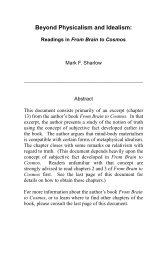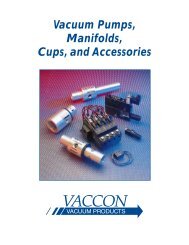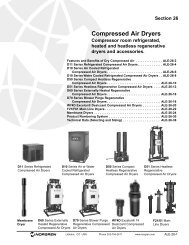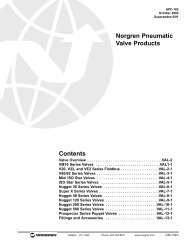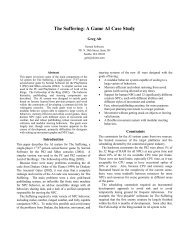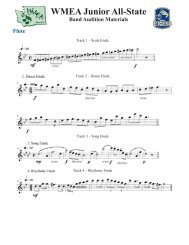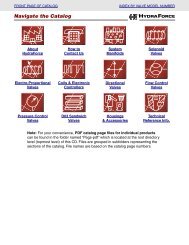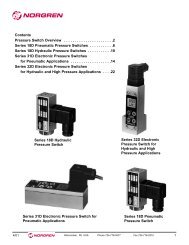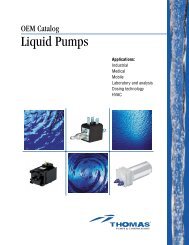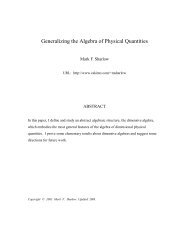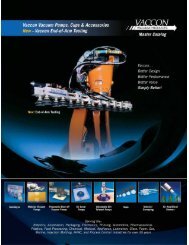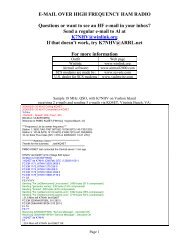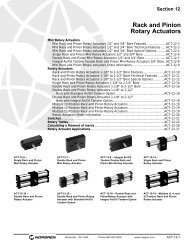Navigate the Catalog HYDRAFORCE
Navigate the Catalog HYDRAFORCE
Navigate the Catalog HYDRAFORCE
- No tags were found...
Create successful ePaper yourself
Turn your PDF publications into a flip-book with our unique Google optimized e-Paper software.
Proportional Valve Controllers—Glossary<br />
ELECTRONIC TERMS & DEFINITIONS<br />
1. Ohms Law: Current = Voltage ÷ Resistance (I = E ÷ R)<br />
2. Current: The flow of electrons in a conductor. It is normally measured in<br />
amperes (A) or milli-amperes (mA). Calculations and electrical diagrams<br />
sometimes use <strong>the</strong> abbreviation “I” to symbolize current.<br />
3. Voltage: The potential for current flow in an electrical circuit. It is measured in<br />
volts, and is sometimes abbreviated (V or E). Generally, higher voltage will<br />
induce higher current.<br />
4. Resistance: Anything that causes an opposition to <strong>the</strong> flow of electrical current.<br />
It is used to control <strong>the</strong> amount of voltage and/or amperage in a circuit.<br />
Everything in a circuit, including wire, causes some resistance. Resistance is<br />
measured in units called Ohms and is sometimes abbreviated “R” or “Ω”<br />
(Greek letter omega).<br />
5. Hysteresis: The measurement of <strong>the</strong> difference in output when current in a<br />
device is increasing vs. when current is decreasing. It is normally expressed<br />
as a percentage of <strong>the</strong> total change in input.<br />
6. Proportional Controller/Amplifier: A device that converts a low-power input<br />
signal into an output signal that is capable of operating <strong>the</strong> valve. This output<br />
signal can be modified to include PWM, ramping, or di<strong>the</strong>r.<br />
7. PWM (Pulse Width Modulation): An efficient technique to control current.<br />
A PWM-switched signal pulses on and off to achieve <strong>the</strong> current flow<br />
required. PWM frequency can be low (100 to 400 Hz) or high (over 5000 Hz).<br />
High frequency produces a more constant ripple-free amperage output.<br />
8. Ramping: The ability to control <strong>the</strong> rate of change of <strong>the</strong> output of an amplifier<br />
or controller.<br />
9. Di<strong>the</strong>r (Current Ripple): A rapid, small movement of <strong>the</strong> valve spool around<br />
<strong>the</strong> desired position. Di<strong>the</strong>r keeps <strong>the</strong> spool moving to avoid “stiction” and to<br />
help average-out hysteresis.<br />
10. I-Min. and I-Max.: The minimum and maximum control current induced into a<br />
proportional valve coil.<br />
11. No Load Power: The power consumed by <strong>the</strong> amplifier or proportional<br />
controller when <strong>the</strong>re is no output to <strong>the</strong> valve coil.<br />
12. Maximum Control Current: The point where increasing current input no<br />
longer results in an increase in valve flow.<br />
13. Threshold Current: The amount of current required to reach <strong>the</strong> point where<br />
increasing current input causes flow from <strong>the</strong> valve to begin to increase<br />
(normally closed valve) or decrease (normally open valve).<br />
14. Compensator: A hydraulic device that maintains a fixed pressure drop across<br />
a fixed or variable orifice by restricting or bypassing flow.<br />
®<br />
<strong>HYDRAFORCE</strong><br />
3.560.2



